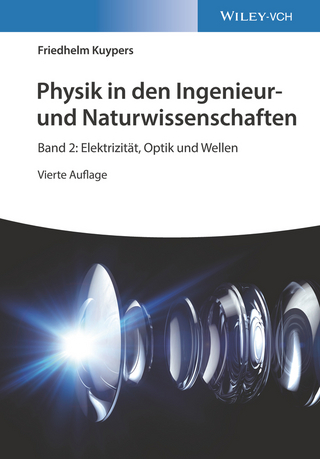
Fundamentals of Digital Image Processing
John Wiley & Sons Inc (Verlag)
978-0-470-84472-4 (ISBN)
- Titel z.Zt. nicht lieferbar
- Versandkostenfrei innerhalb Deutschlands
- Auch auf Rechnung
- Verfügbarkeit in der Filiale vor Ort prüfen
- Artikel merken
This is an introductory to intermediate level text on the science of image processing, which employs the Matlab programming language to illustrate some of the elementary, key concepts in modern image processing and pattern recognition. The approach taken is essentially practical and the book offers a framework within which the concepts can be understood by a series of well chosen examples, exercises and computer experiments, drawing on specific examples from within science, medicine and engineering. Clearly divided into eleven distinct chapters, the book begins with a fast-start introduction to image processing to enhance the accessibility of later topics. Subsequent chapters offer increasingly advanced discussion of topics involving more challenging concepts, with the final chapter looking at the application of automated image classification (with Matlab examples) .
Matlab is frequently used in the book as a tool for demonstrations, conducting experiments and for solving problems, as it is both ideally suited to this role and is widely available. Prior experience of Matlab is not required and those without access to Matlab can still benefit from the independent presentation of topics and numerous examples.
Features a companion website www.wiley.com/go/solomon/fundamentals containing a Matlab fast-start primer, further exercises, examples, instructor resources and accessibility to all files corresponding to the examples and exercises within the book itself.
Includes numerous examples, graded exercises and computer experiments to support both students and instructors alike.
Dr Chris Solomon, Applied Optics Group, School of Physical Sciences, The University of Kent, Canterbury, Kent, UK. Dr Stuart Gibson, VisionMetric, Canterbury, Kent, UK.
Preface xi
Using the book website xv
1 Representation 1
1.1 What is an image? 1
1.1.1 Image layout 1
1.1.2 Image colour 2
1.2 Resolution and quantization 3
1.2.1 Bit-plane splicing 4
1.3 Image formats 5
1.3.1 Image data types 6
1.3.2 Image compression 7
1.4 Colour spaces 9
1.4.1 Rgb 10
1.4.1.1 RGB to grey-scale image conversion 11
1.4.2 Perceptual colour space 12
1.5 Images in Matlab 14
1.5.1 Reading, writing and querying images 14
1.5.2 Basic display of images 15
1.5.3 Accessing pixel values 16
1.5.4 Converting image types 17
Exercises 18
2 Formation 21
2.1 How is an image formed? 21
2.2 The mathematics of image formation 22
2.2.1 Introduction 22
2.2.2 Linear imaging systems 23
2.2.3 Linear superposition integral 24
2.2.4 The Dirac delta or impulse function 25
2.2.5 The point-spread function 28
2.2.6 Linear shift-invariant systems and the convolution integral 29
2.2.7 Convolution: its importance and meaning 30
2.2.8 Multiple convolution: N imaging elements in a linear shift-invariant system 34
2.2.9 Digital convolution 34
2.3 The engineering of image formation 37
2.3.1 The camera 38
2.3.2 The digitization process 40
2.3.2.1 Quantization 40
2.3.2.2 Digitization hardware 42
2.3.2.3 Resolution versus performance 43
2.3.3 Noise 44
Exercises 46
3 Pixels 49
3.1 What is a pixel? 49
3.2 Operations upon pixels 50
3.2.1 Arithmetic operations on images 51
3.2.1.1 Image addition and subtraction 51
3.2.1.2 Multiplication and division 53
3.2.2 Logical operations on images 54
3.2.3 Thresholding 55
3.3 Point-based operations on images 57
3.3.1 Logarithmic transform 57
3.3.2 Exponential transform 59
3.3.3 Power-law (gamma) transform 61
3.3.3.1 Application: gamma correction 62
3.4 Pixel distributions: histograms 63
3.4.1 Histograms for threshold selection 65
3.4.2 Adaptive thresholding 66
3.4.3 Contrast stretching 67
3.4.4 Histogram equalization 69
3.4.4.1 Histogram equalization theory 69
3.4.4.2 Histogram equalization theory: discrete case 70
3.4.4.3 Histogram equalization in practice 71
3.4.5 Histogram matching 73
3.4.5.1 Histogram-matching theory 73
3.4.5.2 Histogram-matching theory: discrete case 74
3.4.5.3 Histogram matching in practice 75
3.4.6 Adaptive histogram equalization 76
3.4.7 Histogram operations on colour images 79
Exercises 81
4 Enhancement 85
4.1 Why perform enhancement? 85
4.1.1 Enhancement via image filtering 85
4.2 Pixel neighbourhoods 86
4.3 Filter kernels and the mechanics of linear filtering 87
4.3.1 Nonlinear spatial filtering 90
4.4 Filtering for noise removal 90
4.4.1 Mean filtering 91
4.4.2 Median filtering 92
4.4.3 Rank filtering 94
4.4.4 Gaussian filtering 95
4.5 Filtering for edge detection 97
4.5.1 Derivative filters for discontinuities 97
4.5.2 First-order edge detection 99
4.5.2.1 Linearly separable filtering 101
4.5.3 Second-order edge detection 102
4.5.3.1 Laplacian edge detection 102
4.5.3.2 Laplacian of Gaussian 103
4.5.3.3 Zero-crossing detector 104
4.6 Edge enhancement 105
4.6.1 Laplacian edge sharpening 105
4.6.2 The unsharp mask filter 107
Exercises 109
5 Fourier transforms and frequency-domain processing 113
5.1 Frequency space: a friendly introduction 113
5.2 Frequency space: the fundamental idea 114
5.2.1 The Fourier series 115
5.3 Calculation of the Fourier spectrum 118
5.4 Complex Fourier series 118
5.5 The 1-D Fourier transform 119
5.6 The inverse Fourier transform and reciprocity 121
5.7 The 2-D Fourier transform 123
5.8 Understanding the Fourier transform: frequency-space filtering 126
5.9 Linear systems and Fourier transforms 129
5.10 The convolution theorem 129
5.11 The optical transfer function 131
5.12 Digital Fourier transforms: the discrete fast Fourier transform 134
5.13 Sampled data: the discrete Fourier transform 135
5.14 The centred discrete Fourier transform 136
6 Image restoration 141
6.1 Imaging models 141
6.2 Nature of the point-spread function and noise 142
6.3 Restoration by the inverse Fourier filter 143
6.4 The Wiener–Helstrom Filter 146
6.5 Origin of the Wiener–Helstrom filter 147
6.6 Acceptable solutions to the imaging equation 151
6.7 Constrained deconvolution 151
6.8 Estimating an unknown point-spread function or optical transfer function 154
6.9 Blind deconvolution 156
6.10 Iterative deconvolution and the Lucy–Richardson algorithm 158
6.11 Matrix formulation of image restoration 161
6.12 The standard least-squares solution 162
6.13 Constrained least-squares restoration 163
6.14 Stochastic input distributions and Bayesian estimators 165
6.15 The generalized Gauss–Markov estimator 165
7 Geometry 169
7.1 The description of shape 169
7.2 Shape-preserving transformations 170
7.3 Shape transformation and homogeneous coordinates 171
7.4 The general 2-D affine transformation 173
7.5 Affine transformation in homogeneous coordinates 174
7.6 The Procrustes transformation 175
7.7 Procrustes alignment 176
7.8 The projective transform 180
7.9 Nonlinear transformations 184
7.10 Warping: the spatial transformation of an image 186
7.11 Overdetermined spatial transformations 189
7.12 The piecewise warp 191
7.13 The piecewise affine warp 191
7.14 Warping: forward and reverse mapping 194
8 Morphological processing 197
8.1 Introduction 197
8.2 Binary images: foreground, background and connectedness 197
8.3 Structuring elements and neighbourhoods 198
8.4 Dilation and erosion 200
8.5 Dilation, erosion and structuring elements within Matlab 201
8.6 Structuring element decomposition and Matlab 202
8.7 Effects and uses of erosion and dilation 204
8.7.1 Application of erosion to particle sizing 207
8.8 Morphological opening and closing 209
8.8.1 The rolling-ball analogy 210
8.9 Boundary extraction 212
8.10 Extracting connected components 213
8.11 Region filling 215
8.12 The hit-or-miss transformation 216
8.12.1 Generalization of hit-or-miss 219
8.13 Relaxing constraints in hit-or-miss: ‘don’t care’ pixels 220
8.13.1 Morphological thinning 222
8.14 Skeletonization 222
8.15 Opening by reconstruction 224
8.16 Grey-scale erosion and dilation 227
8.17 Grey-scale structuring elements: general case 227
8.18 Grey-scale erosion and dilation with flat structuring elements 228
8.19 Grey-scale opening and closing 229
8.20 The top-hat transformation 230
8.21 Summary 231
Exercises 233
9 Features 235
9.1 Landmarks and shape vectors 235
9.2 Single-parameter shape descriptors 237
9.3 Signatures and the radial Fourier expansion 239
9.4 Statistical moments as region descriptors 243
9.5 Texture features based on statistical measures 246
9.6 Principal component analysis 247
9.7 Principal component analysis: an illustrative example 247
9.8 Theory of principal component analysis: version 1 250
9.9 Theory of principal component analysis: version 2 251
9.10 Principal axes and principal components 253
9.11 Summary of properties of principal component analysis 253
9.12 Dimensionality reduction: the purpose of principal component analysis 256
9.13 Principal components analysis on an ensemble of digital images 257
9.14 Representation of out-of-sample examples using principal component analysis 257
9.15 Key example: eigenfaces and the human face 259
10 Image Segmentation 263
10.1 Image segmentation 263
10.2 Use of image properties and features in segmentation 263
10.3 Intensity thresholding 265
10.3.1 Problems with global thresholding 266
10.4 Region growing and region splitting 267
10.5 Split-and-merge algorithm 267
10.6 The challenge of edge detection 270
10.7 The Laplacian of Gaussian and difference of Gaussians filters 270
10.8 The Canny edge detector 271
10.9 Interest operators 274
10.10 Watershed segmentation 279
10.11 Segmentation functions 280
10.12 Image segmentation with Markov random fields 286
10.12.1 Parameter estimation 288
10.12.2 Neighbourhood weighting parameter u n 289
10.12.3 Minimizing U(x | y): the iterated conditional modes algorithm 290
11 Classification 291
11.1 The purpose of automated classification 291
11.2 Supervised and unsupervised classification 292
11.3 Classification: a simple example 292
11.4 Design of classification systems 294
11.5 Simple classifiers: prototypes and minimum distance criteria 296
11.6 Linear discriminant functions 297
11.7 Linear discriminant functions in N dimensions 301
11.8 Extension of the minimum distance classifier and the Mahalanobis distance 302
11.9 Bayesian classification: definitions 303
11.10 The Bayes decision rule 304
11.11 The multivariate normal density 306
11.12 Bayesian classifiers for multivariate normal distributions 307
11.12.1 The Fisher linear discriminant 310
11.12.2 Risk and cost functions 311
11.13 Ensemble classifiers 312
11.13.1 Combining weak classifiers: the AdaBoost method 313
11.14 Unsupervised learning: k-means clustering 313
Further reading 317
Index 319
| Erscheint lt. Verlag | 22.2.2011 |
|---|---|
| Verlagsort | New York |
| Sprache | englisch |
| Maße | 176 x 249 mm |
| Gewicht | 765 g |
| Themenwelt | Naturwissenschaften ► Biologie ► Allgemeines / Lexika |
| Naturwissenschaften ► Physik / Astronomie | |
| ISBN-10 | 0-470-84472-8 / 0470844728 |
| ISBN-13 | 978-0-470-84472-4 / 9780470844724 |
| Zustand | Neuware |
| Informationen gemäß Produktsicherheitsverordnung (GPSR) | |
| Haben Sie eine Frage zum Produkt? |
aus dem Bereich


